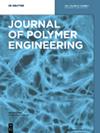熔融混合法制备的聚(3-羟基丁酸酯)纳米复合材料的力学、热学和形貌特性
IF 1.7
4区 工程技术
Q4 POLYMER SCIENCE
引用次数: 0
摘要
本研究的重点是利用熔融混合法制备聚(3-羟基丁酸酯)(PHB)纳米复合材料。在 PHB 基体中以不同的重量百分比加入了两种有机改性纳米粘土:Cloisite 93A (C93A) 和 Cloisite 30B (C30B),从而制备出纳米复合材料。对 PHB/C93A 和 PHB/C30B 进行了比较分析,以评估它们与基体聚合物的拉伸和冲击性能。在这两种纳米复合材料之间,PHB/C93A 纳米复合材料的最佳拉伸模量为 949 兆帕,粘土含量为 3 wt%;而 PHB/C30B 纳米复合材料的断裂伸长率提高了 5.33%,粘土含量为 3 wt%时的伊佐德冲击强度提高了 39.67 J/m。热重分析(TGA)和差示扫描量热法(DSC)显示了基体和纳米复合材料的热行为。据观察,PHB/C30B 纳米复合材料的结晶度为 47%,而 PHB/C93A 纳米复合材料的结晶度为 38%。同样,在热重分析(TGA)中,PHB/C30B 纳米复合材料的最大炭化率为 5.198%。在动态力学分析(DMA)研究中,PHB/C93A 纳米复合材料在约 55-60 °C 的峰值处具有增强的粘弹性行为,这是由于在基体中加入了 C93A 纳米粘土。使用 WAXD 分析法进行的形态学研究显示了颗粒粘土在 PHB 基质中的插层和分散,表明粘土与基质之间存在有效的相互作用。总之,本研究揭示了加入有机粘土后 PHB 纳米复合材料性能的增强,为各行各业提供了潜在的应用领域。本文章由计算机程序翻译,如有差异,请以英文原文为准。
Mechanical, thermal, and morphological properties of poly(3-hydroxy butyrate) nanocomposites prepared by melt mixing method
This research focuses on the preparation of poly (3-hydroxy butyrate) (PHB) nanocomposites using the melt mixing method. Two types of organically modified nanoclay, Cloisite 93A (C93A), and Cloisite 30B (C30B), were incorporated at various weight percentages into the PHB matrix to create the nanocomposites. Comparative analyses were conducted between PHB/C93A and PHB/C30B to assess their tensile and impact properties in relation to the matrix polymer. Between the nanocomposites, the PHB/C93A nanocomposites shows an optimum tensile modulus of 949 Mpa with a 3 wt% clay loading, while PHB/C30B nanocomposites demonstrated improved percentage elongation at break of 5.33 % and enhanced Izod impact strength of 39.67 J/m at 3 wt% of clay load. The thermogravimetric analysis (TGA) and differential scanning calorimetry (DSC) signifies the thermal behavior of both the matrix and nanocomposite. The degree of crystallinity is observed to be 47 % in case of the PHB/C30B nanocomposites as compared to the PHB/C93A nanocomposites as 38 %. Again in case of thermogravimetric analysis (TGA), the maximum % char of 5.198 is observed for the PHB/C30B nanocomposites. The enhanced viscoelastic behavior of the PHB/C93A nanocomposites was attributed at a peak of approx. 55–60 °C due to the incorporation of C93A nanoclay into the matrix in the study of dynamic mechanical analysis (DMA). The morphological investigation using WAXD analysis showcased particle clay intercalation and dispersion within the PHB matrix, indicating effective clay-matrix interactions. Overall, this study sheds light on the enhanced properties of PHB nanocomposites with the incorporation of organoclay, offering potential applications in various industries.
求助全文
通过发布文献求助,成功后即可免费获取论文全文。
去求助
来源期刊

Journal of Polymer Engineering
工程技术-高分子科学
CiteScore
3.20
自引率
5.00%
发文量
95
审稿时长
2.5 months
期刊介绍:
Journal of Polymer Engineering publishes reviews, original basic and applied research contributions as well as recent technological developments in polymer engineering. Polymer engineering is a strongly interdisciplinary field and papers published by the journal may span areas such as polymer physics, polymer processing and engineering of polymer-based materials and their applications. The editors and the publisher are committed to high quality standards and rapid handling of the peer review and publication processes.
 求助内容:
求助内容: 应助结果提醒方式:
应助结果提醒方式:


